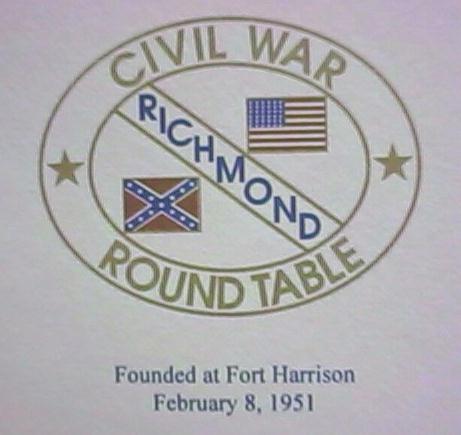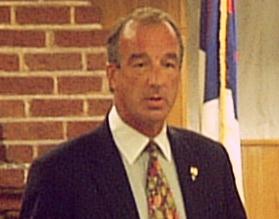


September 2002
rcwrt.org
Clark H. Lewis, President Art & Carol Bergeron, Editors P. O. Box 1122 3901 Paces Ferry Road Richmond, VA 23218 Chester, VA 23831-1239
September 2002 PROGRAM Gordon C. Rhea "The Battle of Cold Harbor" 8:00 p.m., Tuesday, September 10, 2002, at the Boulevard United Methodist Church, 321 N. Boulevard, Richmond, VA (corner of Boulevard and Stuart Ave.) Gordon C. Rhea lives in Mt. Pleasant, South Carolina but is a native of Arlington, Virginia. He holds a bachelor's degree in history from Indiana University, a master's degree in history from Harvard University, and a J. D. degree from Stanford University Law School. Rhea is a partner in the law firm of Alkon and Rhea, where he has worked since 1982. He was Special Assistant to the Chief Counsel, Senate Select Committee on Intelligence Activities, in Washington, D. C., 1975-1976; Assistant United States Attorney, Washington D. C., 1976-1981; and Assistant United States Attorney, U. S. Virgin Islands, 1981-1982. He is married and has two children. Rhea is the author of a number of books, including The Battle of the Wilderness, May 5-6, 1864 (1994); The Battles for Spotsylvania Court House and the Road to Yellow Tavern: May 7-12, 1864 (1997); To the North Anna River: Grant and Lee, May 13-25, 1864 (2000). He has contributed essays to such publications as Gary W. Gallagher (comp.), The Wilderness Campaign (1997); Gary W. Gallagher (comp.), The Spotsylvania Campaign (1998); and The Oxford Companion to American Military History (1999). His most recent publication is Cold Harbor: Grant and Lee, May 26-June 3, 1864, which was recently released by LSU Press. Rhea will give a surprising new interpretation of the famous battle that left seven thousand Union casualties and only fifteen hundred Confederate dead or wounded. Here, Ulysses S. Grant was not a callous butcher, and Robert E. Lee did not wage a perfect fight. He will touch upon the strategies, mistakes, gambles, and problems with subordinates that preoccupied these two exquisitely matched minds. Rhea's research revealed new facts from the records of a phase oddly ignored or mythologized by historians. The Cold Harbor of his new book differs sharply from the Cold Harbor of popular lore. Rhea's presentations are always lively, and this one promises to separate fact from fiction in a charged, evocative manner.
Review of the August Program
 |
Announcements
Fall Tour On October 5, our fall tour will take us to Brandy Station. Clark B. "Bud" Hall, who was one of the driving forces behind the preservation efforts at that battlefield, will serve as tour guide. The cost is very reasonable-just $20 per person. We will depart from the Wal-Mart parking lot at Brooke and Parham at 8 a. m. and return about 5:30 p. m. Everyone should bring a lunch and their own drinks. We will provide pastries and fruit as breakfast, as well as cookies for an afternoon snack. This promises to be one of the best trips the Round Table has been on because we will have access to some areas not normally open to the public. Please bring your check and give it to Art Bergeron at the next meeting or mail it to him at the address shown on the newsletter so that your place on the bus will be reserved.
University of Richmond Class The University of Richmond School of Continuing Studies announces a class titled "Civil War: The Peninsula Campaign." The Civil War came close to ending in the summer of 1862. Throughout the months of April and May, General George McClellan's Army of the Potomac had pushed up the Peninsula of Virginia from Fortress Monroe to the outskirts of Richmond. By June, many Union soldiers reported that they could hear church bells ringing in the city. But the South was not yet defeated, and this threat to Richmond was turned back by General Robert E. Lee in a set of hard-fought battles. This non-credit course will look at the soldiers who fought the Peninsula Campaign of 1862 and will examine developments in Richmond. The class will use a variety of materials furnished by the instructor in support of the four class sessions. A Saturday field trip from Ft. Monroe to the scene of the Seven Days Battles will be led by the instructor. The class will run for four weeks in October, meeting each Monday night from 7:00-9:00 p.m. The bus trip will be held on Saturday, November 2nd. Jack Mountcastle is the course instructor. The fee is $107. For more info, call the School of Continuing Studies at 804-289-8133, or check their website at www.urich.edu, then click on Continuing Studies for info from their fall term "Think Again" catalog.
Museum of the Confederacy Program On Thursday, September 19, at 7:30 p.m., the Museum of the Confederacy will hold it annual Elizabeth Roller Bottimore Lecture in the Perkinson Recital Hall at the University of Richmond. It is free to the public. In 2000, National Park Civil War sites were required to include in their programming the role slavery played as a cause of the Civil War. This raised questions as well as disagreements among historians and battlefield visitors over the manner in which the Civil War should be studied. This year's program will consist of a panel discussion featuring Dr. Edward L. Ayers, professor of history at UVA; Mr. Robert K. Krick, Civil War historian; Dr. Dwight T. Pitcaithley, chief historian of the National Park Service; and Mr. Jerry L. Russell, national chairman of Civil War Round Table Associates. The panelists will look at the amendment's implications and far-reaching effects on historical study by specifically examining the measures and changes at federal Civil War battlefields.
RCWRT Monthly Speakers for 2002
Newsletter Deadlines To facilitate the printing and timely distribution of the monthly newsletter, information for it should be submitted to the editors no later than the following dates: September 20 for October October 18 for November November 22 for December
Richmond Civil War Round Table Newsletter Art & Carol Bergeron, Editors 3901 Paces Ferry Road Chester, VA 23831-1239
Return to News Letters Index
Return to main page

©R.C.W.R.T. 2002